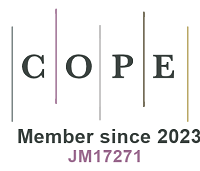REFERENCES
1. Lin T, Yu S, Chen W. Occurrence, removal and risk assessment of pharmaceutical and personal care products (PPCPs) in an advanced drinking water treatment plant (ADWTP) around Taihu Lake in China. Chemosphere 2016;152:1-9.
2. Daughton CG, Ternes TA. Pharmaceuticals and personal care products in the environment: agents of subtle change? Environ Health Perspect 1999;107:907.
3. Heberer T. Tracking persistent pharmaceutical residues from municipal sewage to drinking water. Journal of Hydrology 2002;266:175-89.
4. Heberer T. Occurrence, fate, and removal of pharmaceutical residues in the aquatic environment: a review of recent research data. Toxicol Lett 2002;131:5-17.
5. Hillebrand O, Nödler K, Licha T, Sauter M, Geyer T. Caffeine as an indicator for the quantification of untreated wastewater in karst systems. Water Res 2012;46:395-402.
6. Nödler K, Licha T, Fischer S, Wagner B, Sauter M. A case study on the correlation of micro-contaminants and potassium in the Leine River (Germany). Applied Geochemistry 2011;26:2172-80.
7. Nödler K, Licha T, Voutsa D. Twenty years later-atrazine concentrations in selected coastal waters of the Mediterranean and the Baltic Sea. Mar Pollut Bull 2013;70:112-8.
8. Reh R, Licha T, Geyer T, Nödler K, Sauter M. Occurrence and spatial distribution of organic micro-pollutants in a complex hydrogeological karst system during low flow and high flow periods, results of a two-year study. Sci Total Environ 2013;443:438-45.
9. Ternes T. The occurrence of micopollutants in the aquatic environment: a new challenge for water management. Water Sci Technol 2007;55:327-32.
10. Camacho-Muñoz D, Martín J, Santos JL, Aparicio I, Alonso E. Occurrence, temporal evolution and risk assessment of pharmaceutically active compounds in Doñana Park (Spain). J Hazard Mater 2010;183:602-8.
11. Deblonde T, Cossu-Leguille C, Hartemann P. Emerging pollutants in wastewater: a review of the literature. Int J Hyg Environ Health 2011;214:442-8.
12. Birch GF, Drage DS, Thompson K, Eaglesham G, Mueller JF. Emerging contaminants (pharmaceuticals, personal care products, a food additive and pesticides) in waters of Sydney estuary, Australia. Mar Pollut Bull 2015;97:56-66.
13. Martinelango PK, Gümüş G, Dasgupta PK. Matrix interference free determination of perchlorate in urine by ion association-ion chromatography-mass spectrometry. Anal Chim Acta 2006;567:79-86.
14. Minning T, Lytle DA, Pham M, Kelty K. Systematic evaluation of dissolved lead sorption losses to particulate syringe filter materials. Environ Monit Assess 2015;187:383.
15. Ahmad R, Kookana RS, Alston AM. Syringe Filtration as a source of error in pesticide residue analysis in environmental samples. Bulletin of Environmental Contamination and Toxicology 2001;66:313-8.
16. Carlson M, Thompson RD. Analyte loss due to membrane filter adsorption as determined by high-performance liquid chromatography. J Chromatogr Sci 2000;38:77-83.
17. Heimann AC, Jakobsen R. Filtration through nylon membranes negatively affects analysis of arsenic and phosphate by the molybdenum blue method. Talanta 2007;72:839-41.
18. Liu L, Randolph TW, Carpenter JF. Particles shed from syringe filters and their effects on agitation-induced protein aggregation. J Pharm Sci 2012;101:2952-9.
19. Mitev D, Peshev D, Peev G, Peeva L. Depot effect of bioactive components in experimental membrane filtrations. J Phys : Conf Ser 2017;780:012005.
20. Chen H, Gao B, Li H, Ma LQ. Effects of pH and ionic strength on sulfamethoxazole and ciprofloxacin transport in saturated porous media. J Contam Hydrol 2011;126:29-36.
21. Gibson R, Durán-Álvarez JC, Estrada KL, Chávez A, Jiménez Cisneros B. Accumulation and leaching potential of some pharmaceuticals and potential endocrine disruptors in soils irrigated with wastewater in the Tula Valley, Mexico. Chemosphere 2010;81:1437-45.
22. Rauch-Williams T, Hoppe-Jones C, Drewes JE. The role of organic matter in the removal of emerging trace organic chemicals during managed aquifer recharge. Water Res 2010;44:449-60.
23. Ternes TA, Meisenheimer M, McDowell D, et al. Removal of pharmaceuticals during drinking water treatment. Environ Sci Technol 2002;36:3855-63.
24. Xing B, Pignatello JJ. Time-dependent isotherm shape of organic compounds in soil organic matter: Implications for sorption mechanism. Environ Toxicol Chem 1996;15:1282-8.
25. Xing B, Pignatello JJ, Gigliotti B. Competitive sorption between atrazine and other organic compounds in soils and model sorbents. Environ Sci Technol 1996;30:2432-40.
26. Leboeuf EJ, Weber WJ. A distributed reactivity model for sorption by soils and sediments. 8. sorbent organic domains: discovery of a humic acid glass transition and an argument for a polymer-based model. Environ Sci Technol 1997;31:1697-702.
27. Chandramouli B, Benskin JP, Hamilton MC, Cosgrove JR. Sorption of per- and polyfluoroalkyl substances (PFASs) on filter media: implications for phase partitioning studies. Environ Toxicol Chem 2015;34:30-6.
28. Labadie P, Chevreuil M. Biogeochemical dynamics of perfluorinated alkyl acids and sulfonates in the River Seine (Paris, France) under contrasting hydrological conditions. Environ Pollut 2011;159:3634-9.
29. Wu D, Sui Q, Yu X, et al. Identification of indicator PPCPs in landfill leachates and livestock wastewaters using multi-residue analysis of 70 PPCPs: Analytical method development and application in Yangtze River Delta, China. Sci Total Environ 2021;753:141653.
30. Ahrens L, Taniyasu S, Yeung LW, et al. Distribution of polyfluoroalkyl compounds in water, suspended particulate matter and sediment from Tokyo Bay, Japan. Chemosphere 2010;79:266-72.
31. Baduel C, Paxman CJ, Mueller JF. Perfluoroalkyl substances in a firefighting training ground (FTG), distribution and potential future release. J Hazard Mater 2015;296:46-53.
32. Hytteborn JK, Temnerud J, Alexander RB, et al. Patterns and predictability in the intra-annual organic carbon variability across the boreal and hemiboreal landscape. Sci Total Environ 2015;520:260-9.
33. Hillebrand O, Musallam S, Scherer L, Nödler K, Licha T. The challenge of sample-stabilisation in the era of multi-residue analytical methods: a practical guideline for the stabilisation of 46 organic micropollutants in aqueous samples. Sci Total Environ 2013;454-455:289-98.
34. Tran NH, Hu J, Ong SL. Simultaneous determination of PPCPs, EDCs, and artificial sweeteners in environmental water samples using a single-step SPE coupled with HPLC-MS/MS and isotope dilution. Talanta 2013;113:82-92.
35. Fox JW. Sample preparation in biological mass spectrometry. J Am Soc Mass Spectrom 2012;23:1440.
36. Godby N, Conklin A. Comparing adsorption of bisphenol A and similar compounds in aqueous solution by syringe filters. Adsorption Science & Technology 2016;35:153-61.
37. Hebig KH, Nödler K, Licha T, Scheytt TJ. Impact of materials used in lab and field experiments on the recovery of organic micropollutants. Sci Total Environ 2014;473-474:125-31.
38. Wang S, Li J, Suo J, Luo T. Surface modification of porous poly(tetrafluoraethylene) film by a simple chemical oxidation treatment. Applied Surface Science 2010;256:2293-8.
39. Wang F, Zhu H, Zhang H, et al. Effect of surface hydrophilic modification on the wettability, surface charge property and separation performance of PTFE membrane. Journal of Water Process Engineering 2015;8:11-8.
40. Nghiem L, Schäfer A, Waite T. Adsorptive interactions between membranes and trace contaminants. Desalination 2002;147:269-74.
41. Cartinella JL, Cath TY, Flynn MT, et al. Removal of natural steroid hormones from wastewater using membrane contactor processes. Environ Sci Technol 2006;40:7381-6.
42. Taheran M, Brar SK, Verma M, et al. Membrane processes for removal of pharmaceutically active compounds (PhACs) from water and wastewaters. Sci Total Environ 2016;547:60-77.
43. Braeken L, Ramaekers R, Zhang Y, et al. Influence of hydrophobicity on retention in nanofiltration of aqueous solutions containing organic compounds. Journal of Membrane Science 2005;252:195-203.
44. Han J, Qiu W, Gao W. Adsorption of estrone in microfiltration membrane filters. Chemical Engineering Journal 2010;165:819-26.







